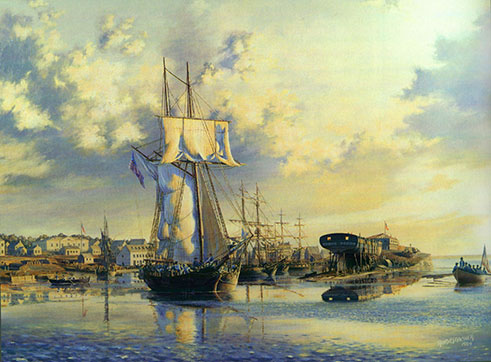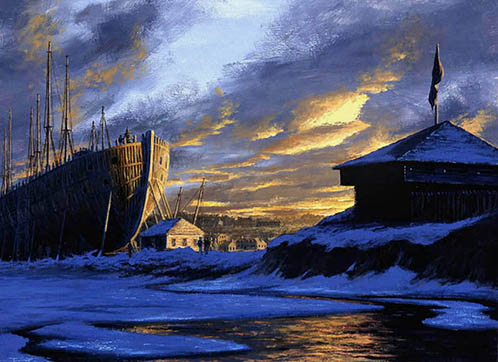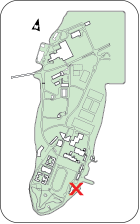In early 1813, the main American forces concentrated at Sackets Harbor. Their naval and military formations under Commodore Isaac Chauncey and Major-General Henry Dearborn dominated both Lake Ontario and the borders in overwhelming numbers. They could have stormed Kingston and eliminated the British Squadron, but exaggerated estimates of British regulars there made them cautious. Instead they attacked York, the Provincial capital, at the other end of the Lake.

A contemporary drawing of Sackets Harbor in September 1815 by Lieutenant E.T. Vidal, RN, depicting the Hospital, Fort Pike, barracks, 10 ships, one under construction, and Fort Tomkin.

Painting: Sunset at Sackets Harbor illustrating U.S. schooner Hamilton emerging from the harbour and, in the background the warship General Pike under construction. Painting courtesy of the artist, Peter Rindlisbacher.

Painting: Winter at Sackets Harbor illustrating the American answer to the launching of HMS St. Lawrence, a ship-of-the-line, the building of two even larger ships, one of which is shown here. Painting courtesy of the artist, Peter Rindlisbacher.
On 27 April, the Americans won this battle, but rapidly withdrew to Fort Niagara near the mouth of the Niagara River, preparing to attack the British position at Fort George opposite them. This decision gave the Anglo-Canadian forces at Kingston a strategic and tactical opportunity against Sackets Harbor. On 29 May 1813, a British force attempted to capture or destroy a new warship being built there. While repulsed, there was much damage to American ship construction and stores. Learning of the attack, the unnerved Chauncey hurriedly returned to his base, vowing not to leave again until his new warship was completed. Clearly, Lake Ontario was so important neither side would risk a decisive engagement. The struggle over the Lake seemed more about ships' carpenters than naval tacticians.
Walking Tour

Panel 3 is located just to the south of panel 2 and is oriented towards Sackets Harbor, some 45 kms to the southeast in Northern New York. These two panels are located approximately where the slips were located during the construction of HMS St. Lawrence, Canada, and Wolfe.